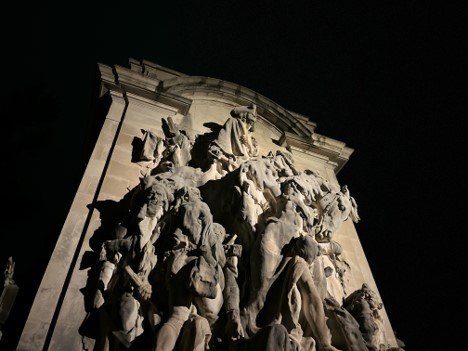The Ten Crucial Days, 200 Years Later: How the Trentonian Transported Central Jersey Back to 1776
This is the third in a series of blogs, created in partnership with Princeton University, entitled Commemoration, Crisis and Revolution in the City. To learn more about the research behind this project, visit https://commons.princeton.edu/commemorating/
***
In 1976, Trenton, New Jersey was an industrial town on the decline, sandwiched between two metropolitan areas that threatened to swallow the city through rapid suburbanization.[1] The heavily built-up area was a far cry from the small river port on the Delaware River General George Washington’s troops entered on Christmas 1776. While thousands of motorists cross the river on the way to work every morning rather unremarkably, two hundred years prior it was the revolutionary forces who rowed across the icy Delaware to launch a surprise attack that would change the trajectory of the war.[2] In a move to connect what was now a mundane and declining mid-sized city to the nation’s exciting revolutionary past, the Trentonian, a newspaper in Trenton, printed a free special issue on July 5, 1976 to commemorate the bicentennial that featured stories about the battles that shaped the ten crucial days, written by reporters as if they were reporting in real time.[3] The Trentonian deployed sensationalized reporting to connect its readership in central New Jersey to the region’s past as an integral area to the war that led to the founding of the nation.
The “Trenton Makes, the World Takes” bridge serves a reminder of the city’s industrial past.
“Ask any schoolchild about the Battle of Trenton and invariably you will be told that it was ‘the turning point of the American Revolution,’” wrote Emil Slaboda, then-editor of the Trentonian, “And it was,” he adds.[4] Throughout the special issue, the Trentonian uses immersion and dramatization to heighten the role of Trenton in the revolution and immerse readers in the region’s revolutionary history. Were it not for the modern English employed, readers would not know that the articles supposedly written in 1776 were actually penned in the middle of the twentieth century. Quotes are employed from generals to provide a sense of real-time reporting, while costumed soldiers posed for modern-day photographs that give the appearance of the existence of cameras in 1776.[5]
The issue also makes extensive use of geographical markers to spatially position troops in the readers mind, providing a glossary of changed street and city names at the beginning of the paper to help readers identify the waypoints they see on a daily basis as having revolutionary significance.[6] Throughout the pages of the issue, a sense of triumphalism prevails, with authors waxing poetic of the glorious victories of the revolutionary forces leading readers to almost believe that the surrender of the British themselves had been secured in January 1777. The conflict, of course, was far from over in 1777 and it would take another six years before the British surrendered to Washington’s forces.[7]
The Princeton Battle Monument serves as a reminder of the Ten Crucial Days in which General Washington and his army turned the tide in the Revolutionary War.
The Trentonian’s immersive look at 1776 shows us how commemoration in New Jersey sought to build a sense of pride in the state and region’s residents in their revolutionary past. For a state wedged between of what were then the country’s second and third largest states, New Jersey—and especially the suburban expanse of central Jersey—can feel overlooked. Latent throughout this issue is a belief that this lack of attention on New Jersey is unjust. From the very beginning of the special issue, the Trentonian’s leadership stated that “…history books fall far short of telling the complete story of the Battles of Trenton and Princeton.” [8] Through immersing the reader in the events of that crucial winter and lauding the significance of central New Jersey to the establishment of the United States, the Trentonian helped the citizens of a declining region living in tough economic times feel a connection to the region’s past — that at one point, only 200 years ago, this place helped change the course of world events.
Ryan Konarska is a junior at Princeton University studying Public and International Affairs originally from Metro Detroit. On campus, he is a Managing Editor at The Daily Princetonian and an Advising Fellow for Matriculate college advising.
[1] Jennifer Altmann, “History: Trenton in the ’60s,” Princeton Alumni Weekly, July 10, 2019.
[2] “Traffic Counts,” Delaware River Joint Toll Bridge Commission, 2023.
[3] “‘10 Crucial Days’ Free on Monday,” The Trentonian, July 3, 1976.
[4] Emil Slaboda, “The Ten Crucial Days,” The Trentonian, July 5, 1976.
[5] “Americans’ Night of Decision,” The Trentonian, July 5, 1976; “Surprise Attack Routs Hessians,” The Trentonian,” July 5, 1976.
[6] “The Story…,” The Trentonian,” July 5, 1976.
[7] John Cunningham, “A Royalist Atrocity at Union,” The Revolution in New Jersey, 1975; “Out of Ruin, a Victory,” The Trentonian,” July 5, 1976.
[8] “Happy Birthday America!,” The Trentonian,” July 4, 1976.



